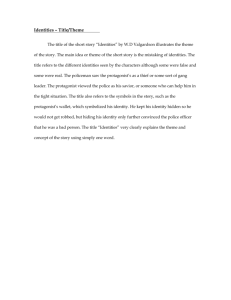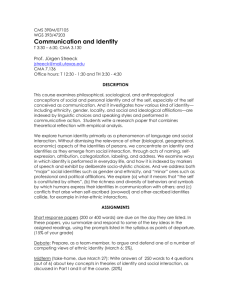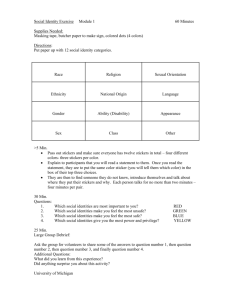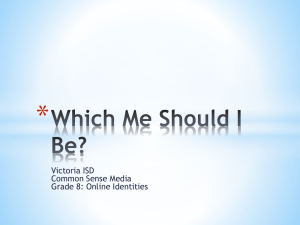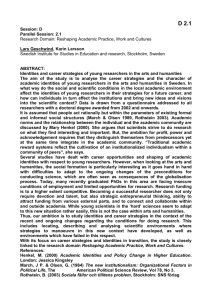“Being Middle-Eastern American: Identity Negotiation in the Context
advertisement
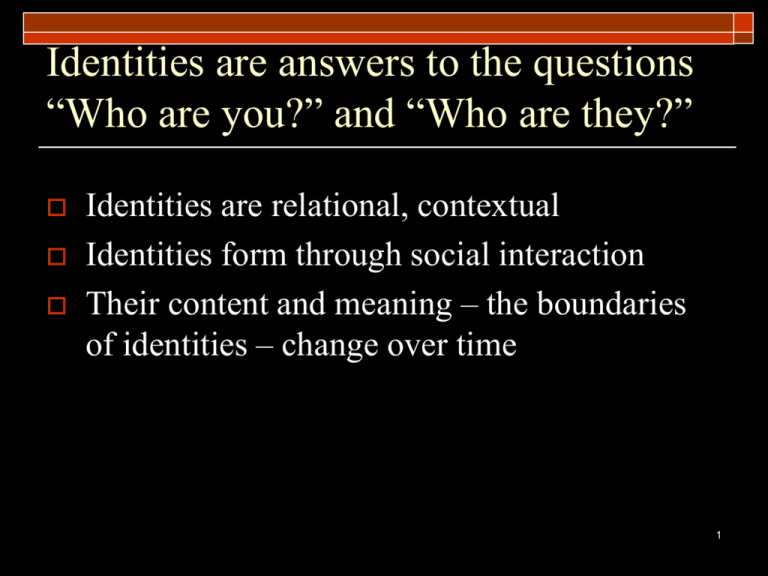
Identities are answers to the questions “Who are you?” and “Who are they?” Identities are relational, contextual Identities form through social interaction Their content and meaning – the boundaries of identities – change over time 1 Identities consist of: a boundary separating me from you or us from them a set of relations within the boundary a set of relations across the boundary a set of stories about the boundary and relations Tilly, 1999 Identities form through pairing - comparing, contrasting, & relating - social categories a social category consists of a set of sites that share a boundary distinguishing all of them and relating all of them to at least one set of sites visibly excluded by the boundary identities separate us from them, imply distinct relations among us, among them, and between us and them Tilly, 1999 3 Ch. 42: Being Middle-Eastern American: Identity Negotiation in the Context of the War on Terror Amir Marvasti Stigma & management of spoiled identity objective: to show how Middle Eastern Americans manage the stigma of their “spoiled identities,” especially in the aftermath of September 11th analytical method: combines symbolic interactionism (SI) and structuralism SI attends to how meanings and identities are constructed through everyday social interaction, while structuralism focuses on how micro-level interactions are conditioned by social structure - social context and history 5 Goffman on stigma “When a stranger is present before us, evidence can arise of his possessing an attribute that makes him different from others…He is thus reduced in our minds from a whole and usual person to a tainted, discounted one. Such an attribute is stigma.” Stigma is variable social construct and not a fixed characteristic of a person 6 Identity disputes are occasions for eliciting and producing “accounts” accounts: encounters in which a person is called to explain unanticipated or untoward behavior—whether his/her own or that of others, and whether the cause of the statement arises from the actor himself or someone else accounts are conditioned by structural factors, social-historical context, e.g., political turmoil war 7 Media images shape social context Middle Eastern Americans are suffering “ill-fame” (Goffman, 1963) perpetuated by the mass media their “public image . . . seems to be constituted from a small selection of facts which . . . are inflated into dramatic newsworthy appearance, and then used as a full picture [of their identity],” e.g., racist stereotypes and fear of terrorism perpetuated by the media the stigma of being Middle Eastern American is not external to interactions but is constructed or rejected via interaction, accounts, & self-presentational strategies 8 Five forms of accounting strategies humorous accounting educational accounting defiant accounting cowering passing 9 Humorous Accounting uses humor as a diversion technique substance of account is incidental and is deliberately trivialized account-giver acknowledges demands of encounter while undermining legitimacy and urgency of request for an account 10 Educational Accounting takes deliberate pedagogical form where account-giver assumes role of educator, informing & instructing account-taker combats stigma by correcting stereotypes unlike humorous accounting, educational accounting centers on the informational substance of the account 11 Defiant Accounting like humorous accounting, account-giver exerts agency by challenging other’s right to request unlike humorous accounting, stigmatized make explicit demands for counter-explanations interaction explicitly focused on the fairness of the exchange 12 Cowering in “defensive cowering” (Goffman) the stigmatized go along with stereotypical demands of setting in order to avoid greater harm artful practice and agency take backseat to external conditions stigmatized is virtually powerless in the face of rigid demands of the setting more about “saving body,” or one’s physical safety, than “saving face” 13 Passing goal is information control and concealment of stigmatizing attributes accomplished by manipulating one’s appearance, e.g., using disindentifiers 14 Trafficking Migration, and the Law: Protecting Innocents, Punishing Immigrants Wendy Chapkis Deviance and the law law is a key means for the construction of deviance, especially those not white, not native born, and not sexually restrained by marriage new laws defining deviance and crime are often the product of a moral panic 16 Trafficking Victims Protection Act divides “violated innocents” from “illegal immigrants” relies on a repressive moral panic about sexual slavery created through slippery stats & definitions differentiates between innocent and guilty prostitutes, providing support only to former makes assistance, even to “deserving” victims contingent on willingness to assist in prosecution 17 “Right to Remain Silent” (audio) For 17 months, New York police officer Adrian Schoolcraft recorded himself and his fellow officers on the job, including their supervisors ordering them to do all sorts of things that police aren't supposed to do. For example, downgrading real crimes into lesser ones, so they wouldn't show up in the crime statistics and make their precinct look bad. Adrian's story first appeared as a five part series in the Village Voice, written by Graham Rayman. Schoolcraft's website looking for other cops to come forward is here. (41 minutes) 18



